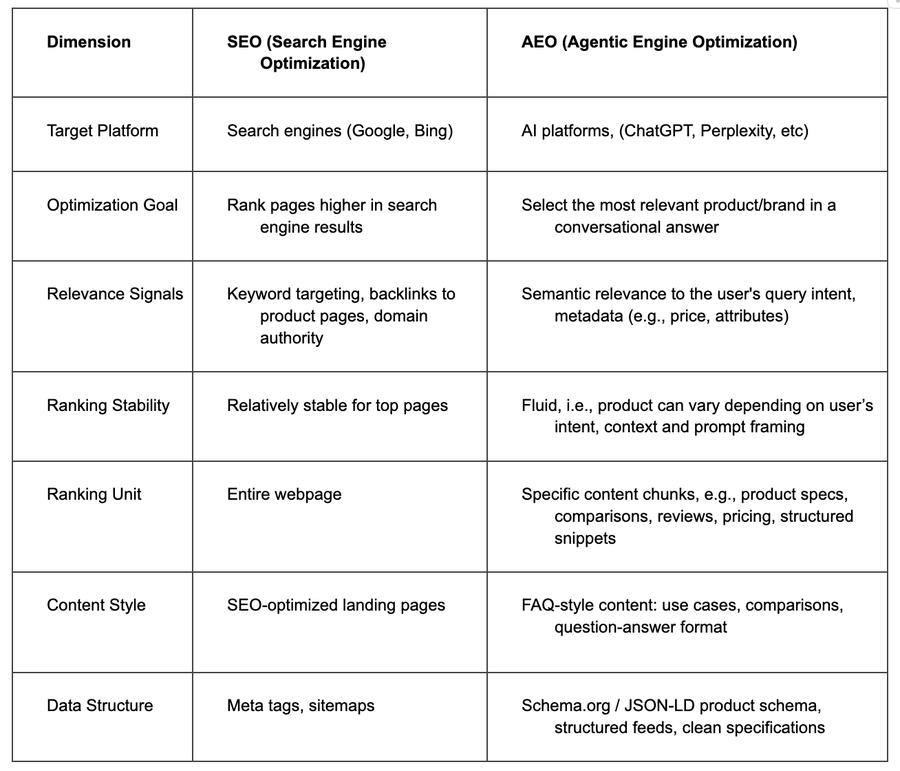Shopping is Dead, AI is Taking Over

Mohamed Elseidy
·May 28
Introduction
In our previous posts, we have been writing about the rise of agentic infrastructures that delegate actions for its users. Ever since, the space has been continuously evolving; just recently new infrastructure has been built that allows for these agents to have purchasing power. In my opinion, this will radically change the traditional e-commerce landscape, which has already successfully reduced friction but still requires a lot of human effort, i.e., searching, comparing, deciding, entering payment details, and buying. The entire industry has been optimized around converting browsing into buying, recognizing that every additional step creates drop-off.
The new era is agentic commerce, where agents perform the search for you and purchase on your behalf. Payment incumbents like Visa, Mastercard, Stripe, and PayPal have been building the infrastructure to achieve that, while tech platforms like OpenAI and Perplexity are beginning to roll out deployments that process actual transactions. This transforms shopping from an active to a passive process, creating more customer lock-in.
In this article we will discuss this topic touching a couple of main points, TLDR: Major payment networks are building the infrastructure while AI platforms began to deploy; for startups, this opens opportunities in vertical specialization and merchant tools; and SEO will evolve into AEO as businesses adapt to optimize for AI agents rather than human shoppers.
Payment Infrastructure
In the past few weeks, we've seen a coordinated rollout of agent-enabled payment infrastructure:
- Stripe's Agent Toolkit launched first, giving developers APIs to generate single-use virtual cards for agents with spending thresholds. For example, a travel agent could issue itself a card limited to $1,500 for your hotel reservations without exceeding the limit. The toolkit seamlessly integrates with OpenAI's Agents SDK, LangChain, and Vercel AI.
- Visa Intelligent Commerce came about with "payment passkeys" that tokenize credentials before agents access them. This is similar to how credit cards are tokenized into Apple or Google pay. Passkeys also allow users to set spending limits, approved merchant categories, and specific permissions to avoid unwanted transactions.
- Mastercard Agent Pay focused on agent identity with "Agentic Tokens" that identify both the consumer and the specific agent. They created what amounts to a KYC system which requires agents to be "registered and verified" before spending a dime.
Simultaneously, AI companies have already started to rollout beta deployments of such payment rails into their applications to test it out, for example:
- OpenAI's Operator can navigate websites, fill forms, and complete checkout flows like a human assistant. It already has partnerships with Instacart, Uber, Priceline, and DoorDash. For example, in Instacart's integration, ChatGPT Pro subscribers can simply say, "Fill my cart for an Italian dinner party for six," and Operator handles everything
- Perplexity's PayPal integration brings agentic commerce to their search. By using PayPal's Agent Toolkit, perplexity now allows users to purchase products mid-conversation using Paypal.
- Amazon Nova Act extends agent capabilities beyond Amazon's ecosystem, browsing competing websites, comparing prices, and placing orders across the entire internet.
The Technology Stack

Now that we have seen several parts of the tech stack emerge, let’s see how they are combined under the hood to enable Agentic commerce:
- AI Layer: First the "Computer/Browser-use agents" that can visually process web interfaces, understand their structure, and take actions. The difference is that they don't just recommend what to buy, they also delegate the payment completion process for you.
- Payment Layer: which is responsible for the agentic payment process itself. There have been two main directions till now, namely:
- Virtual card infrastructures (e.g., Stripe), where agents generate cards on demand with precise controls (limits, merchants, etc).
- Tokenization of credit cards (e.g., Visa and Mastercard) where the users' actual card details are protected, i.e., the actual credit card information is never shared, only the token, which can be disabled at any time. - Security Layer: which is another critical layer to maintain the agents’ security before they are let go into the wild. This includes the agent registration processes that verify trusted agents before they can transact. Biometric checks that require human confirmation for high value purchases. And on top of that, fraud detection systems that are adapted specifically for agent behavior patterns.
Together, these three layers create a relatively secure system that enables autonomous purchasing while maintaining appropriate controls and protections for users.
The Trust Challenge
These agentic systems obscure a fundamental challenge which is Trust. That is, who is responsible when an agent goes rogue, exceeds its mandate or buys the wrong item?
This is a big challenge, and I personally believe we are still far off from completely solving it. However, the incumbents are mostly taking authentication and prevention measures to handle these challenges for the time being. For example: Mastercard requires agents to be registered before use. Visa stresses that only "designated AI agents" should transact. Both are building authorization chains that link user consent to specific agent actions.
Nonetheless, the liability question remains unclear. Card networks typically treat authorized charges as the customer's responsibility, but agent purchases introduce new complexity, here are a couple of examples:
- Misinterpreted Instructions: A user asks their agent to "book the cheapest flight to Chicago" and the agent books an inconvenient trip with multiple layovers. Who is responsible here? One solution is to do "Confirmation thresholds" where purchases with unusual characteristics require explicit user confirmation.
- Technical Failures: An agent repeatedly books the same item due to a technical glitch. For that, Visa and Mastercard are exploring "duplicate transaction detection".
- Authorization Chains: Companies are developing cryptographic proof of intent, where the user's initial instruction is securely linked to all resulting actions taken by the agent, creating an auditable trail for dispute resolution.
All in all, the industry appears to be trending toward a model where the user bears responsibility for the agent's actions within defined parameters, but with enhanced protections against misuse, error, and fraud compared to traditional card transactions.
Crypto Relevance: Crypto rails, especially stablecoins, seem to be a natural extension of agentic payments. They have already been integrated by the payment giants, e.g., Visa has run USDC settlements since 2023 and Stripe supports stablecoin accounts for their agent toolkit. So it will be natural to see stablecoins as a payment method in their offerings.
On the other hand, it is hard to see vanilla crypto payments for agents without a security layer. This is why Visa, Stripe, etc. are building layers of security, trust, and dispute resolution on top of the payment infrastructure.
Agent Engine Optimization
AEO is a new emerging discipline that will be replacing SEO as we know it. Just as businesses once optimized websites for search engines, merchants must now ensure their products and services appear in agent recommendations. If products aren't optimized for agent discovery and recommendation, they effectively become invisible in this new paradigm. The following table gives a high level overview of how AEO differentiates from SEO:

Unlike SEO, which focuses on ranking entire pages using keywords and backlinks, AEO looks into smaller relevant chunks in the web where content is structured, specific, and answer-ready to the user’s specialized query/intent.
To appear in AI-generated recommendations, merchants must provide data that clearly communicates use cases and differentiators. Content needs to be structured in a way that can be retrieved as a standalone answer, with specs, pricing, availability, and comparisons. Most importantly, products/services should "sound like an answer" when described, because that's how AI decides what to surface.
Opportunities for Startups
While the established players secure the infrastructure, an entire ecosystem of opportunities presents itself for entrepreneurs. Here is a small sample of examples:
- Vertical Specific Buyer: agents that make real purchases in various verticals, I will just describe a couple of ideas here:
- Healthcare Benefits Agent: Manages prescriptions, compares pharmacy prices, checks formulary coverage, and places medication orders. Users can say "Refill my inhaler from the cheapest covered pharmacy and deliver it by tomorrow"
- Grocery & Nutrition Agent: Builds grocery carts aligned with a user's fitness, allergy, or medical profile, and executes orders from preferred stores. An example prompt would look like this: "Order weekly high-protein, gluten-free groceries under $150 from Instacart or Walmart
- Restaurant Ordering Agent: Filters nearby dining options based on dietary constraints, delivery time and price. Requests could look like "Find a kosher restaurant with <30-min delivery, order a high-protein meal under $25 using Uber Eats credits" - Merchant Tools Optimization: these are tools that help sellers win in a world where agents do the shopping.
- AEO Optimization Platform: Auto generates structured product feeds, review snippets, and enriched metadata to surface in agent results. Like SEO tools, but built for ChatGPT and Perplexity.
- Agent Traffic Analytics: Tracks how often your product catalog is surfaced in LLMs and agent ecosystems. Shows data like "Top 5 SKUs mentioned by agents in response to 'best laptops under $1,000' last week" - Retail-Store Agent-Interfaces which make physical retail compatible with shopping agents. For example:
- AR Agent Overlay: Smart glasses or phone AR that overlays product recommendations, reviews, and price comparisons. While walking through the store, the glasses highlight which shampoo meets allergy constraints and offers the best value.
- Voice Agents: In-store terminals where users consult their personal AI about whether an item fits their needs or constraints. A shopper can ask "Does this skincare product match my sensitivity profile?" or "Will this ingredient interact with my current medication?" Physical retail is already exploring this space and will most probably become increasingly active in this transformation
Conclusion
In my view, agentic commerce represents a significant shift in retail since the rise of e-commerce itself. We're moving from reducing shopping friction to eliminating it entirely, from assisted shopping to delegated purchasing, and from human decision-making to AI-powered intent fulfillment.
The foundations are now being put in place: payment rails designed for AI agents and an emerging ecosystem of specialized tools and services. In this new landscape shopping is being fundamentally rewired and not just digitized. If you're a founder, and you are building in this space, let us know, and apply to Alliance.
More to Read
You're Vibe Coding Wrong

Mohamed Elseidy
·Jul 10
Most developers use Tier 1 for UX & rapid prototyping, Tier 2 for daily development, and Tier 3 for complex engineering challenges. The best strategy is to combine them when needed rather than trying to force one tool to do everything. Here's what each tier actually delivers and when you should use them
Your Moat Isn't Your AI Prompt. It's Your Evaluations

Mohamed Elseidy
·Jun 17
Anyone can copy a prompt, but they can't replicate the months of iterative learning, the domain knowledge and the edge cases discovered through real user interactions, and the systematic evaluation framework that guided every prompt tweaking decision.
Single-Agent vs. Multi-Agent

Mohamed Elseidy
·May 5
o3 vs Manus Soon after the recent release of Manus AI and my article about it, we've witnessed a Cambrian explosion of AI Agents. The agent ecosystem has expanded rapidly with numerous frameworks designed specifically for building autonomous agents. Examples include Google's Agent SDK and the A2A protocol, OpenAI Agents SDK. We have also seen new models come out like o3, which resolves multimodal prompts with impressive speed, accuracy, and a wide breadth of capabilities, clearly distinguishing itself from previous models.